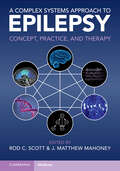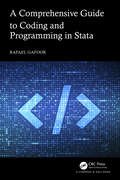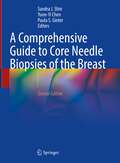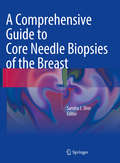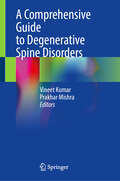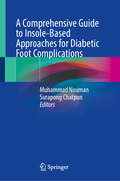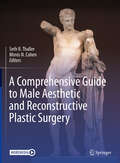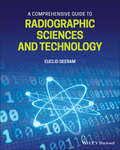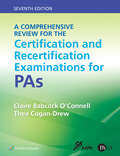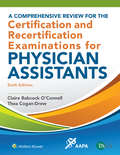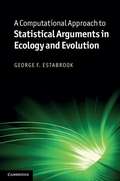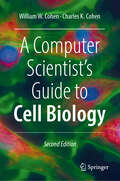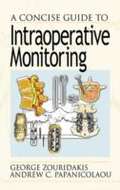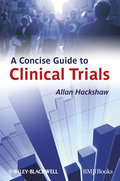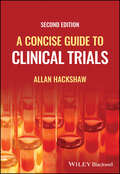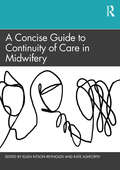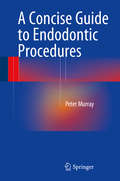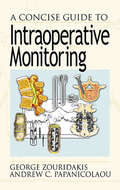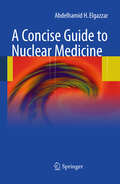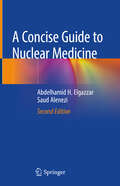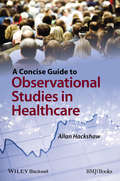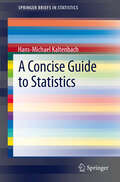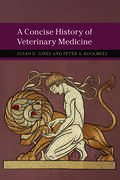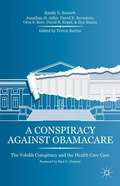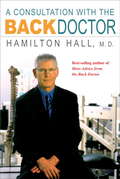- Table View
- List View
A Complex Systems Approach to Epilepsy: Concept, Practice, and Therapy
by Rod C. Scott J. Matthew MahoneyThe epilepsies are devastating neurological disorders for which progress developing effective new therapies has slowed over recent decades, primarily due to the complexity of the brain at all scales. This reality has shifted the focus of experimental and clinical practice toward complex systems approaches to overcoming current barriers. Organized by scale from genes to whole brain, the chapters of this book survey the theoretical underpinnings and use of network and dynamical systems approaches to interpreting and modeling experimental and clinical data in epilepsy. The emphasis throughout is on the value of the non-trivial, and often counterintuitive, properties of complex systems, and how to leverage these properties to elaborate mechanisms of epilepsy and develop new therapies. In this essential book, readers will learn key concepts of complex systems theory applied across multiple scales and how each of these scales connects to epilepsy.
A Comprehensive Guide to Coding and Programming in Stata
by Rafael GafoorThis book is an introductory guide to programming and coding in Stata. Commonly encountered code in the field of medical statistics as well as the analyses of observational data are presented.For those who are involved in the analyses of observational studies, the need to sometimes assemble large datasets will necessitate a detailed understanding of loops and macros. This book covers these materials early on and then describes other commonly required coding commands.For those who program in a controlled environment (.e.g. medical statisticians who perform analyses for regulatory bodies), the production of log files, a suggested folder structure and analysis pathway are covered. This book also includes a wide range of tabulation commands and other methods of producing tables of descriptive statistics. The text also then provides a clear explanation of how to perform some inferential analyses (including how to extract and format the coefficients for use in subsequent reports).The focus on coding allows beginners to grasp the basics of coding and programming, as well as allowing established researchers to hone their skills and become more advanced programmers.Key Features: Covers the fundamental of using and understanding Stata. Able to be used by anyone looking to learn the basics of coding. Introduces and explains difficult concepts such as macros from the outset.
A Comprehensive Guide to Core Needle Biopsies of the Breast
by Sandra J. Shin Yunn-Yi Chen Paula S. GinterBreast cancer remains the leading cause of cancer in women, which makes accurate diagnoses on core needle biopsy (CNB) specimens of vital importance in staging and guiding therapy decisions for patients. The first edition of this multi-authored text written by leaders in the field from major academic medical centers provided a comprehensive guide on diagnostic breast pathology in the core biopsy setting. In addition to in-depth coverage of benign and malignant entities encountered in breast core biopsies, the book provided additional resources to improve diagnostic accuracy such as pattern-based approaches to evaluation, mimickers of breast lesions arising in extra-mammary sites, and pitfalls specific to small tissue samples. In recent years, there have been several notable developments in the field of breast pathology including revisions in AJCC breast cancer staging, updated guidelines in the testing and reporting of ER, PR, and HER2, as well as implementation of immunotherapy and companion biomarker testing. In addition, several key updates were included in the most recent edition of the WHO Classification of Breast Tumours (2020). In addition to updates specific to individual breast entities, the second edition will detail updates regarding biomarker testing in the primary and metastatic setting, and incorporate newly defined entities and updated definitions of rare tumors in alignment with the WHO Classification of Breast Tumours (2020). Furthermore, this edition will address the role of CNB in companion biomarker testing for eligibility for immunotherapy in the context of advanced triple-negative breast carcinoma. Written by leaders in the field and edited by expert breast pathologists, The Second Edition of Comprehensive Guide to Core Needle Biopsies of the Breast is the definitive reference on breast core needle biopsies for practicing pathologists, pathology trainees, oncologists and clinicians of patients with breast disease.
A Comprehensive Guide to Core Needle Biopsies of the Breast
by Sandra J. ShinThis first multi-authored work exclusively dedicated to breast lesions in core needle biopsy samples, A Comprehensive Guide to Core Needle Biopsies of the Breast is an all-inclusive textbook that provides an overview of the fundamentals of a breast core needle biopsy program, instructive topics on diagnostic approaches to breast core biopsies including a pattern-based strategy, and in-depth coverage of all entities commonly seen in the core biopsy setting. In addition, chapters detailing special scenarios or topics including the role of molecular profiling in small breast samples and personalized medici≠ metastasis to the breast and dermatologic mimickers of breast lesions arising in the breast skin, subcutis or axilla complete the impressive scope of this authoritative book. The book features over 900 high-quality images, charts, and diagrams. Written by leaders in the field and edited by expert breast pathologist, Dr. Sandra J. Shin, A Comprehensive Guide to Core Needle Biopsies of the Breast is the definitive reference on breast core needle biopsies for practicing pathologists, pathology trainees, and clinicians of patients with breast disease.
A Comprehensive Guide to Degenerative Spine Disorders
by Vineet Kumar Prakhar MishraThis comprehensive book on degenerative spine disorders offers valuable insights into symptoms, diagnostic methods, and treatment options. It empowers both medical professionals and laypeople to navigate the complexities of these prevalent conditions. By dissecting the underlying causes and presenting a holistic understanding, the book goes beyond the surface, providing a vital resource for anyone involved in spinal health. Medical professionals gain in-depth knowledge, while individuals grappling with these disorders find a roadmap for managing challenges and fostering empowerment on their journey toward spinal health. This book targets post-graduate residents and spine fellows. This book equips medical students with a solid foundation in understanding the issues surrounding low back pain. Through its comprehensive content, clinical insights, and patient-centric approach, the book provides a valuable resource for medical education and future clinical practice.
A Comprehensive Guide to Insole-Based Approaches for Diabetic Foot Complications
by Muhammad Nouman Surapong ChatpunThis comprehensive book covers a wide range of topics, providing valuable insights and evidence-based information on insole-based approaches for managing diabetic foot complications. These include custom-made insoles, offloading insoles, and therapeutic footwear, with different materials, shapes, and designs, clinical evaluation and prescription, current research trends, and real-life case studies, emphasizing their impact on plantar pressure distribution and overall foot health. The insole design plays a crucial role in reducing plantar pressures and preventing ulcers. The book delves into design features such as metatarsal additions, rocker soles, and cushioning with the importance of comfort, durability, and pressure redistribution. Healthcare professionals need to assess patients&’ individual needs and prescribe appropriate insoles. The book provides guidelines for evaluating foot biomechanics, gait patterns, and pressure points. Case studies illustrate how customized insoles can improve patient outcomes and prevent complications. Additionally, the book discusses cutting-edge research on insole technologies, topics including smart insoles with sensor technology, pressure-sensing insoles, and wearable devices. The book provides practical examples to demonstrate how insole-based approaches impact patient care. These case studies showcase successful outcomes, patient adherence, and the role of customized insoles in preventing ulcers. The primary audience for the book is podiatrists, orthopedic surgeons, endocrinologists, primary care physicians, and other healthcare providers specializing in diabetes management.
A Comprehensive Guide to Male Aesthetic and Reconstructive Plastic Surgery
by Mimis N. Cohen Seth R. ThallerThis book offers an authoritative and comprehensive overview of the wide range of surgical procedures and non-invasive options for the male cosmetic and reconstructive patients. Chapters examine the full gamut of unique male aesthetic and reconstructive surgical procedures, written by an interdisciplinary team of well-known and well-respected national and international contributors. The book provides an up-to-date and highly illustrated coverage of existing techniques and innovative, new technologies. Chapters relay the interplay between the unique male anatomy, expectations, clinical implications, therapeutic gems and approach to men seeking aesthetic enhancements. Each chapter highlights a concise but comprehensive description of the clinical issue augmented by appropriate illustrations, related art works, and videos. When applicable, an interdisciplinary style utilizing the expertise of allied specialties such as dermatology, facial plastic surgery, and oculoplastic surgery are utilized.Chapters address key issues and areas not previously included in other books, such as:Direct excision of nasolabial folds and submental regionFacial rejuvenation and other aesthetic procedure available to people of colorSurgery for body buildersBuried penisManagement of hyperhidrosisHIV: facial wasting and buffalo humpA Comprehensive Guide to Male Aesthetic and Reconstructive Surgery is a must-have resource for plastic and reconstructive surgeons to successfully manage the distinctive, unique needs of the male patient.
A Comprehensive Guide to Radiographic Sciences and Technology
by Euclid SeeramA comprehensive and succinct guide to radiographic physics and imaging, covering all the core components of the radiographic sciences, including digital imaging production and equipment, radiation protection and safety, and the principles of Computed Tomography. Designed to support students preparing to sit certification and board examinations, including the American Registry for Radiologic Technologists (ARRT) and other global radiography certification examinations. Addresses the core radiographic science components of the ASRT curriculum, including digital imaging production and equipment, radiation protection and safety, and the principles of Computed Tomography. Useful for students and practitioners in diagnostic medical radiation technology, radiography and medical radiation sciences, as well as in biomedical engineering technology.
A Comprehensive Review for the Certification and Recertification Examinations for PAs
by Claire Babcock O’Connell Thea Cogan-DrewEndorsed by the American Academy of PAs (AAPA) and the Physician Assistant Education Association (PAEA), A Comprehensive Review for the Certification and Recertification Examinations for PAs is a trusted resource for mastering the core information you need to know to pass the Physician Assistant National Certifying Exam (PANCE) or the Physician Assistant National Recertifying Exam (PANRE). The most complete resource of its kind, this updated edition reflects the latest developments in the field and features engaging study tools, review questions, and new quick-review Pearls to reinforce your knowledge, guide your studying, and increase test-taking confidence.
A Comprehensive Review for the Certification and Recertification Examinations for Physician Assistants: In Collaboration With Aapa And Paea
by Claire O'ConnellPrepare for PANCE or PANRE with the most trusted review tool, A Comprehensive Review for the Certification and Recertification Examinations for Physician Assistants
A Computational Approach to Statistical Arguments in Ecology and Evolution
by George EstabrookScientists need statistics. Increasingly this is accomplished using computational approaches. Freeing readers from the constraints, mysterious formulas and sophisticated mathematics of classical statistics, this book is ideal for researchers who want to take control of their own statistical arguments. It demonstrates how to use spreadsheet macros to calculate the probability distribution predicted for any statistic by any hypothesis. This enables readers to use anything that can be calculated (or observed) from their data as a test statistic and hypothesize any probabilistic mechanism that can generate data sets similar in structure to the one observed. A wide range of natural examples drawn from ecology, evolution, anthropology, palaeontology and related fields give valuable insights into the application of the described techniques, while complete example macros and useful procedures demonstrate the methods in action and provide starting points for readers to use or modify in their own research.
A Computer Scientist's Guide to Cell Biology
by William W. Cohen Charles K. CohenUnlike the structured world of computer science, biology is complex, evolving, and often lacks clean abstract models. This book aims to serve as a guide for computer scientists who need to understand cell biology, breaking the field into three parts: biological mechanics, experimental methods, and language/nomenclature. While biological mechanics, which investigates cellular-level details, is covered by many texts, this book also focuses on experimental methods – how biologists conduct experiments and gather data - and on helping the reader understand the language and terminology of biology, which is rich but challenging for non-biologists. A Computer Scientist's Guide to Cell Biology uses a metaphor of biology as a strange land with an unfamiliar language and customs. The goal of the book is to provide a high-level introduction to cell biology, simplifying concepts and relating them to familiar ideas from computer science, so that working computer scientists can more effectively understand read recent research papers and results.This Second Edition contains a number of updates, including discussions of CRISPR, advances in DNA Sequencing, and mRNA vaccines. It serves as an easy-to-read travel guide for computer scientists navigating the intricate and sometimes perplexing terrain of cell biology, offering insights into experimental methods and helping bridge the gap between the structured world of computer science and the complexities of biological systems.
A Concise Guide To Intraoperative Monitoring
by George Zouridakis Andrew PapanicolaouCovering both the applications and the related theory, A Concise Guide to Intraoperative Monitoring provides a general but comprehensive introduction to IOM. Unlike existing texts that typically report the results of specific studies, this book presents comprehensive coverage of the entire procedure, as well as the specific protocols used in hospital practice, examples of typical recordings, possible problems, and recommended solutions. At the end of each chapter the author poses several questions for review. These questions help technologists and medical residents in their preparation for the board exams. Taken together, these features make the book an ideal reference or training manual. <p><p> A Concise Guide to Intraoperative Monitoring begins by discussing the basic principles underlying the generation of bioelectrical signals. It then describes the electronic equipment and the various electrophysiological procedures involved in IOM. From this foundation, the book gradually advances to more specific topics, such as surgical procedures, neuronal structures at risk, the optimum combinations of tests to administer, and the proper interpretation of test results. The material also provides you with a background on general anesthesia and analyzes the effects of various drugs on electrophysiological recordings. A Concise Guide to Intraoperative Monitoring also discusses the proper placement of stimulation and recording electrodes, as well as intervention strategies and equipment troubleshooting.
A Concise Guide to Clinical Trials
by Allan HackshawClinical trials have revolutionized the way disease is prevented, detected and treated, and early death avoided, and they continue to be an expanding area of research. They are central to the work of pharmaceutical companies, and there are many academic and public sector organizations that conduct trials on a wide variety of interventions, including drugs, devices, surgical techniques, and changes in behaviour and lifestyle. A Concise Guide to Clinical Trials provides a comprehensive yet easy-to-read overview of the design, conduct and analysis of trials. It requires no prior knowledge on the subject as the important concepts are introduced throughout. There are chapters that distinguish between the different types of trials, and an introduction to systematic reviews, health-related quality of life and health economic evaluation. The book also covers the ethical and legal requirements in setting up a clinical trial due to an increase in governance responsibilities and regulations. This practical guidebook is ideal for busy clinicians and other health professionals who do not have enough time to attend courses or search through extensive textbooks. It will help anyone involved in undertaking clinical research, or those reading about trials. The book is aimed at: Those wishing to learn about clinical trials for the first time, or as a quick reference guide, for example as part of a taught course on clinical trials Health professionals who wish to conduct their own trials, or participate in other people’s studies People who work in pharmaceutical companies, grant funding organisations, or regulatory agencies
A Concise Guide to Clinical Trials
by Allan HackshawDesign and execute life-saving trials with this accessible resource Clinical trials have revolutionized the treatment of disease and the development of life-saving pharmaceuticals. They contribute decisively to diagnosis, the avoidance of early death, medical intervention and are central to the modern work of pharmaceutical producers. The design and execution of clinical trials is one of the fastest-growing and most important areas of medical and pharmaceutical research. A Concise Guide to Clinical Trials provides an accessible and comprehensive survey of clinical trials, their design, and their applications. Beginning with a taxonomy of trial types, the book overviews stages of analysis, ethical and legal requirements, and more. Now fully updated to reflect the latest research and clinical practice, it continues to be an indispensable resource for researchers and clinicians. Readers of the second edition of A Concise Guide to Clinical Trials will also find: New material on pharmaceutical trials, adaptive designs, and the use of “big data” The easy-to-use organization facilitates both first-time learning and reference Detailed treatment of concepts such as health technology assessments (HTA), patient and public involvement and engagement (PPIE), and more A Concise Guide to Clinical Trials is ideal for clinicians and healthcare professionals looking for a working knowledge of clinical trials, as well as for pharmaceutical workers and regulators looking to understand this vital aspect of the industry.
A Concise Guide to Continuity of Care in Midwifery
by Ellen Kitson-ReynoldsContinuity of care in midwifery – the most traditional way of practising – has been overlooked for much of the last century but is re-emerging as an evidence-based model of care, one which is known to benefit women. This book is a vital companion to students and qualified midwives as continuity of care is integrated into midwifery education and services. A practical, easy-to-read guide to practising caseload midwifery, this book outlines the contemporary political and professional context for midwifery care, different models of care, and the evidence and outcomes associated with continuity of carer. It discusses the real-life concerns, challenges and opportunities of working closely with women throughout their pregnancy and birth, covering key issues such as risk assessment, consent, boundaries, time management, documentation, communication, burnout and decision-making. Supporting the development of midwives from students to newly qualified professionals and beyond, it ends with a chapter containing a range of resources for reference, including helpful tools and worksheets. Including vignettes from students, qualified midwives, and women and their partners, this book is designed for anyone new to practising midwifery continuity of care.
A Concise Guide to Endodontic Procedures
by Peter MurrayThis clinical guide is a concise up-to-date resource that covers a wide range of endodontic procedures, including non-surgical root canal therapy, surgical root canal therapy, trauma care and the management of fractured teeth, apexification, apexogenesis, revascularization, regeneration, Cvek partial pulpotomy, root canal retreatment, and periapical surgery. The provision of numerous flowcharts, checklists, and advice on error avoidance for each procedure will assist in decision-making in daily practice. Scientific and clinical evidence regarding the use and efficacy of the different forms of treatment is summarized, and helpful information is also presented on instrumentation. The inclusion of exam questions will assist those preparing for endodontic examinations. A Primer on Endodontic Treatment will be of value for dental students, residents in training to become endodontists, endodontists, pediatric dentists, and established dentists.
A Concise Guide to Intraoperative Monitoring
by George Zouridakis Andrew C. PapanicolaouCovering both the applications and the related theory, A Concise Guide to Intraoperative Monitoring provides a general but comprehensive introduction to IOM. Unlike existing texts that typically report the results of specific studies, this book presents comprehensive coverage of the entire procedure, as well as the specific protocols used in hospit
A Concise Guide to Nuclear Medicine
by Abdelhamid H. ElgazzarNuclear medicine is an important component of modern medicine. This easy-to-use book is designed to acquaint readers with the basic principles of nuclear medicine, the instrumentation used, the gamut of procedures available, and the basis for selecting specific diagnostic or therapeutic procedures and interpreting results. After an introductory chapter on the history, technical basis, and scope of nuclear medicine, a series of chapters are devoted to the application of nuclear medicine techniques in the different body systems. In addition, the use of nuclear medicine methods within oncology is carefully examined, covering diagnosis, staging, assessment of treatment response, radiotherapy planning, and the sentinel node technique. The book concludes with a chapter devoted to nuclear medicine therapy. This practical and up-to-date guide to nuclear medicine is ideal for beginners and will also help professionals who need to retrieve useful information rapidly.
A Concise Guide to Nuclear Medicine
by Abdelhamid H. Elgazzar Saud AleneziThis book, now in an extensively revised second edition, summarizes the basic principles of nuclear medicine and describes the clinical applications of commonly used nuclear medicine procedures and techniques. Readers will find clear explanation of clinical indications, the pathophysiological basis of functional procedures, and the complementary role of nuclear medicine and molecular imaging in relation to diagnostic radiology. Throughout, emphasis is placed on the added diagnostic value offered by the new hybrid imaging modalities. The various therapeutic applications of nuclear medicine are also discussed. Compared with the first edition, technical details have been significantly simplified. The book will be an ideal introduction to nuclear medicine for medical students and will serve as an excellent quick reference for referring physicians, enabling them to utilize this modern medical specialty more efficiently.
A Concise Guide to Observational Studies in Healthcare
by Allan HackshawA Concise Guide to Observational Studies in Healthcare provides busy healthcare professionals with an easy-to-read introduction and overview to conducting, analysing and assessing observational studies.It is a suitable introduction for anyone without prior knowledge of study design, analysis or conduct as the important concepts are presented throughout the text. It provides an overview to the features of design, analyses and conduct of observational studies, without using mathematical formulae, or complex statistics or terminology and is a useful guide for researchers conducting their own studies, those who participate in studies co-ordinated by others, or who read or review a published report of an observational study. Examples are based on clinical features of people, biomarkers, lifestyle habits and environmental exposures, and evaluating quality of care.A Concise Guide to Observational Studies in Healthcare is a companion text to the popular A Concise Guide to Clinical Trials and is relevant for all healthcare professionals, clinical and health researchers, and medical students.
A Concise Guide to Statistics (SpringerBriefs in Statistics)
by Hans-Michael KaltenbachThe text gives a concise introduction into fundamental concepts in statistics. Chapter 1: Short exposition of probability theory, using generic examples. Chapter 2: Estimation in theory and practice, using biologically motivated examples. Maximum-likelihood estimation in covered, including Fisher information and power computations. Methods for calculating confidence intervals and robust alternatives to standard estimators are given. Chapter 3: Hypothesis testing with emphasis on concepts, particularly type-I , type-II errors, and interpreting test results. Several examples are provided. T-tests are used throughout, followed important other tests and robust/nonparametric alternatives. Multiple testing is discussed in more depth, and combination of independent tests is explained. Chapter 4: Linear regression, with computations solely based on R. Multiple group comparisons with ANOVA are covered together with linear contrasts, again using R for computations.
A Concise History of Veterinary Medicine (New Approaches to the History of Science and Medicine)
by Susan D. Jones Peter A. KoolmeesFrom Ayurvedic texts to botanical medicines to genomics, ideas and expertise about veterinary healing have circulated between cultures through travel, trade, and conflict. In this broad-ranging and accessible study spanning 400 years of history, Susan D. Jones and Peter A. Koolmees present the first global history of veterinary medicine and animal healing. Drawing on inter-disciplinary and multi-disciplinary perspectives, this book addresses how attitudes toward animals, disease causation theories, wars, problems of food insecurity and the professionalization and spread of European veterinary education have shaped new domains for animal healing, such as preventive medicine in intensive animal agriculture and the need for veterinarians specializing in zoo animals, wildlife, and pets. It concludes by considering the politicization of animal protection, changes in the global veterinary workforce, and concerns about disease and climate change. As mediators between humans and animals, veterinarians and other animal healers have both shaped, and been shaped by, the social, cultural, and economic roles of animals over time.
A Conspiracy Against Obamacare
by Trevor BurrusThe Affordable Care Act debate was one of the most important and most public examinations of the Constitution in our history. At the forefront of that debate were the bloggers of the Volokh Conspiracy who, from before the law was even passed, engaged in a spirited, erudite, and accessible discussion of the legal issues involved in the case.
A Consultation With the Back Doctor
by Hamilton HallThe latest advice from the original bestselling Back DoctorTwenty-five years ago, Dr. Hamilton Hall wrote the book that changed the way back-pain sufferers deal with their affliction. In The Back Doctor, he advocated activity instead of bed rest. In place of braces and girdles, he suggested that patients follow a program of specific exercise. Most of all, he took the mystery out of back pain.Three out of four Canadian adults, and an increasing number of children, suffer some form of back discomfort. They make up a huge and lucrative market for unscrupulous practitioners. New treatments - new drugs, new devices, and supposedly new, high-tech therapies - are advertised daily. New controversies, such as a recent scare about chiropractic neck manipulation, find their way into newspaper headlines. A Consultation with the Back Doctor is Dr. Hall's response to these and other developments.This is a completely new book. It is written, like its predecessors, in an informal, easy-to-understand question-and-answer format. Readers will come away with a sound understanding of their condition and a practical course of action to make it better.From the Hardcover edition.
